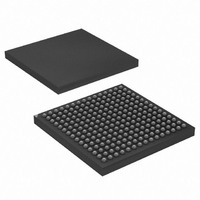AT91CAP7E-NA-ZJ Atmel, AT91CAP7E-NA-ZJ Datasheet - Page 216

AT91CAP7E-NA-ZJ
Manufacturer Part Number
AT91CAP7E-NA-ZJ
Description
MCU CAP7 FPGA 225LFBGA
Manufacturer
Atmel
Series
CAP™r
Specifications of AT91CAP7E-NA-ZJ
Core Processor
ARM7
Core Size
16/32-Bit
Speed
80MHz
Connectivity
EBI/EMI, FPGA, IrDA, SPI, UART/USART, USB
Peripherals
DMA, POR, PWM, WDT
Number Of I /o
32
Program Memory Size
256KB (256K x 8)
Program Memory Type
ROM
Ram Size
160K x 8
Voltage - Supply (vcc/vdd)
1.08 V ~ 1.32 V
Data Converters
A/D 8x10b
Oscillator Type
Internal
Operating Temperature
-40°C ~ 85°C
Package / Case
225-LFBGA
Processor Series
AT91Mx
Core
ARM7TDMI
Data Bus Width
32 bit
3rd Party Development Tools
JTRACE-ARM-2M, MDK-ARM, RL-ARM, ULINK2
Lead Free Status / RoHS Status
Lead free / RoHS Compliant
Eeprom Size
-
Lead Free Status / Rohs Status
Details
Available stocks
Company
Part Number
Manufacturer
Quantity
Price
- Current page: 216 of 520
- Download datasheet (11Mb)
PLL A and divider A are enabled. PLL A input clock is main clock divided by 5. PLL An out-
put clock is PLL A input clock multiplied by 4. Once CKGR_PLLAR has been written,
LOCKA bit will be set after six slow clock cycles.
4. Setting PLL B and divider B:
All parameters needed to configure PLL B and divider B are located in the CKGR_PLLBR
register.
The DIVB field is used to control divider B itself. A value between 0 and 255 can be pro-
grammed. Divider B output is divider B input divided by DIVB parameter. By default DIVB
parameter is set to 0 which means that divider B is turned off.
The OUTB field is used to select the PLL B output frequency range.
The MULB field is the PLL B multiplier factor. This parameter can be programmed between
0 and 2047. If MULB is set to 0, PLL B will be turned off, otherwise the PLL B output fre-
quency is PLL B input frequency multiplied by (MULB + 1).
As stated previously in this chapter and due to the tuning of the internal PLLB filter for USB
operation, DIVB and MULB should be programmed to generate a 96 MHz PLL clock for opti-
mum performance. Other settings are likely to produce an output clock with reduced quality.
The PLLBCOUNT field specifies the number of slow clock cycles before LOCKB bit is set in
the PMC_SR register after CKGR_PLLBR register has been written.
Once the PMC_PLLB register has been written, the user must wait for the LOCKB bit to be
set in the PMC_SR register. This can be done either by polling the status register or by wait-
ing the interrupt line to be raised if the associated interrupt to LOCKB has been enabled in
the PMC_IER register. All parameters in CKGR_PLLBR can be programmed in a single
write operation. If at some stage one of the following parameters, MULB, DIVB is modified,
LOCKB bit will go low to indicate that PLL B is not ready yet. When PLL B is locked, LOCKB
will be set again. The user is constrained to wait for LOCKB bit to be set before using the
PLL A output clock.
The USBDIV field is used to control the additional divider by 1, 2 or 4, which generates the
USB clock(s). As mentioned in an earlier paragraph, should be normally set to divide the 96
MHz PLLB output clock by 2 and thereby generate the 48 MHz USB clocks.
Code Example:
write_register(CKGR_PLLBR,0x00040805)
If PLL B and divider B are enabled, the PLL B input clock is the main clock. PLL B output
clock is PLL B input clock multiplied by 5. Once CKGR_PLLBR has been written, LOCKB bit
will be set after eight slow clock cycles.
AT91CAP7E
216
8549A–CAP–10/08
Related parts for AT91CAP7E-NA-ZJ
Image
Part Number
Description
Manufacturer
Datasheet
Request
R

Part Number:
Description:
Customizable Microcontroller
Manufacturer:
ATMEL Corporation
Datasheet:

Part Number:
Description:
DEV KIT FOR AVR/AVR32
Manufacturer:
Atmel
Datasheet:

Part Number:
Description:
INTERVAL AND WIPE/WASH WIPER CONTROL IC WITH DELAY
Manufacturer:
ATMEL Corporation
Datasheet:

Part Number:
Description:
Low-Voltage Voice-Switched IC for Hands-Free Operation
Manufacturer:
ATMEL Corporation
Datasheet:

Part Number:
Description:
MONOLITHIC INTEGRATED FEATUREPHONE CIRCUIT
Manufacturer:
ATMEL Corporation
Datasheet:

Part Number:
Description:
AM-FM Receiver IC U4255BM-M
Manufacturer:
ATMEL Corporation
Datasheet:

Part Number:
Description:
Monolithic Integrated Feature Phone Circuit
Manufacturer:
ATMEL Corporation
Datasheet:

Part Number:
Description:
Multistandard Video-IF and Quasi Parallel Sound Processing
Manufacturer:
ATMEL Corporation
Datasheet:

Part Number:
Description:
High-performance EE PLD
Manufacturer:
ATMEL Corporation
Datasheet:

Part Number:
Description:
8-bit Flash Microcontroller
Manufacturer:
ATMEL Corporation
Datasheet:

Part Number:
Description:
2-Wire Serial EEPROM
Manufacturer:
ATMEL Corporation
Datasheet:











